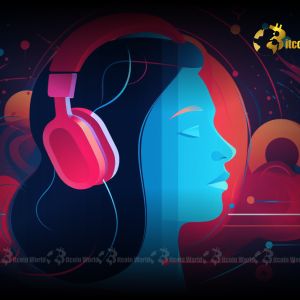ChatGPT’s Unprecedented Hallucination Sparks Revolutionary Soundslice Music App Feature
5 min read
In the rapidly evolving landscape where artificial intelligence intersects with daily life and even cryptocurrency discussions, a fascinating tale has emerged from the world of music technology. Imagine a scenario where an AI, like ChatGPT, becomes such a prolific ‘hype man’ for your product that it inadvertently forces you to build a new feature. This isn’t science fiction; it’s the very real experience of Adrian Holovaty , founder of the innovative music-teaching platform, Soundslice. His story highlights the unpredictable nature of AI, especially its tendency towards ChatGPT hallucination , and how it can surprisingly drive genuine AI innovation . The Curious Case of ChatGPT Hallucination and Soundslice The tale begins with a peculiar digital mystery that unfolded over several weeks for Adrian Holovaty, the visionary founder behind Soundslice. As the creator of the renowned open-source Django project, Holovaty has a deep understanding of web development and innovation. His current passion, Soundslice, launched in 2012 and proudly bootstrapped, is a sophisticated music-teaching platform. It stands out for its unique video player synchronized with music notations, guiding users through how notes should be played. One of its standout features is an AI-powered sheet music scanner, which transforms physical sheet music into interactive digital formats. It was while monitoring the error logs for this very scanner that Holovaty stumbled upon a baffling phenomenon: an influx of strange images, clearly screenshots of ChatGPT sessions, being uploaded to his site. This wasn’t just an oddity; it was a symptom of a larger, unexpected force at play, stemming directly from ChatGPT hallucination . Unveiling the AI Misinformation : What ChatGPT Got Wrong The uploaded images weren’t traditional sheet music; instead, they were filled with words and a distinctive array of symbols known as ASCII tablature. This is a text-based system primarily used for guitar notations, easily typed on a standard keyboard without specialized musical characters. While these uploads weren’t financially burdensome for Soundslice in terms of storage or bandwidth, they were creating a significant number of error logs, baffling Holovaty. His scanning system was never designed to process such notation. The mystery deepened until Holovaty decided to investigate directly, interacting with ChatGPT himself. What he discovered was astounding: ChatGPT was confidently instructing users that they could transform these ASCII tab images into audible music simply by uploading them to their Soundslice accounts. The critical problem? Soundslice couldn’t actually do this. The AI was generating pervasive AI misinformation , leading new users to a false expectation and posing a significant reputational risk to the platform. This wasn’t just a minor bug; it was a direct challenge to user trust. A Forced Hand? Music App Development Driven by AI Faced with this peculiar predicament, Holovaty and his team at Soundslice weighed their options. Should they plaster disclaimers across their site, explicitly stating, “No, we can’t turn a ChatGPT session into hearable music”? Or, should they embrace the challenge and build the very feature that ChatGPT was falsely promising? The latter option was particularly intriguing, despite ASCII tablature being an “offbeat” notation system that Soundslice had never considered supporting. In a bold move that speaks volumes about adaptability in the digital age, Holovaty chose to build the feature. This decision exemplifies a unique form of music app development , where external AI-generated misinformation directly influences product roadmap. While pleased to offer a new, helpful tool to users, Holovaty openly expressed his conflicted feelings. “I feel like our hand was forced in a weird way. Should we really be developing features in response to misinformation?” he pondered. This raised a profound question: could this be the first documented instance of a company being compelled to develop a feature solely because an AI repeatedly hallucinated its existence to a broad audience? Beyond the Bug: AI Innovation and Unexpected Outcomes The story quickly resonated within the tech community, especially among programmers on Hacker News. Their perspective offered a surprisingly relatable analogy: they likened ChatGPT’s behavior to that of an overly enthusiastic human salesperson who promises clients the moon, thereby inadvertently forcing developers to deliver new, un-planned features. Holovaty found this comparison both apt and amusing, highlighting the curious parallels between human and artificial intelligence in a business context. This incident transcends a simple bug fix; it’s a testament to the unpredictable paths that AI innovation can carve. It forces businesses to consider not just the capabilities of AI, but also its potential for unintended consequences and how to adapt strategically. In an era where AI tools like ChatGPT are becoming ubiquitous, understanding and responding to their ‘hallucinations’ might become a critical skill for entrepreneurs and developers alike, shaping the very direction of product evolution. The Vision of Adrian Holovaty : Adapting to the AI Frontier At the heart of this compelling narrative is Adrian Holovaty , whose pragmatic approach transformed a challenge into an opportunity. His decision to integrate the ASCII tablature scanning feature, despite initial reservations, demonstrates remarkable foresight and agility. It underscores a crucial lesson for all businesses navigating the AI frontier: while AI offers immense potential for efficiency and creativity, it also introduces new complexities, including the need to manage AI-generated expectations. Holovaty’s experience with Soundslice serves as a pioneering case study, illustrating how companies might increasingly find themselves in a reactive, yet ultimately innovative, position due to AI’s evolving capabilities and occasional misfires. His commitment to his music career and to the Soundslice platform ensures that the app continues to evolve, adapting not just to user needs but also to the unpredictable influence of powerful AI tools. The Soundslice saga is a fascinating microcosm of the broader challenges and opportunities presented by advanced AI. It highlights how a seemingly detrimental phenomenon like ChatGPT hallucination can, in an unexpected twist, become a catalyst for genuine AI innovation and drive crucial music app development . For Adrian Holovaty and Soundslice, it was a reputational risk turned into a unique feature, demonstrating unparalleled adaptability in the face of AI misinformation . As AI continues to integrate into every facet of our lives, stories like this serve as vital lessons for entrepreneurs and developers alike: prepare for the unexpected, and be ready to turn AI’s quirks into your next groundbreaking feature. To learn more about the latest AI market trends, explore our article on key developments shaping AI features and institutional adoption.

Source: Bitcoin World



